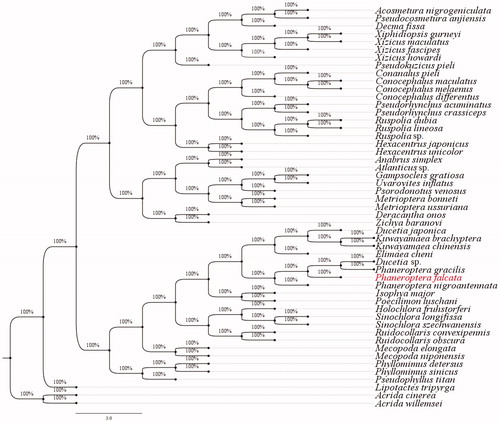Abstract
In the present study, we determined the complete mitochondrial genome sequence of Phaneroptera falcata by next-generation sequencing. The complete mitogenome of P. falcata is 15,672 bp in length, and has the typical gene arrangement of the ancestral sequence. The P. falcata mitogenome contained 37% A, 17.6% C, 10.7% G, and 34.7% T bases, with an AT bias of 71.8%, and consists of 13 protein-coding genes (PCGs), 22 transfer RNA (tRNA) genes, two ribosomal RNA (rRNA) genes and one D-loop. We constructed Bayesian inference tree using mitogenomes of 49 species from Tettigoniidae including P. falcata, and the results of this study provided basis for the study of the phylogenetic evolution of the genus Phaneroptera.
Phaneroptera falcata belongs to Phaneropterinae, Tettigoniidae, Orthoptera, and is mainly distributed in the eastern and southern parts of Europe, South China (Fujian, Hunan), East China (Anhui, Shanghai, Jiangsu, Zhejiang), Central China (Hubei), Southwest China (Sichuan, Yunnan, Chongqing), Northwest China (Shaanxi, Gansu), North China (Hebei, Inner Mongolia), Northeast China (Jilin, Heilongjiang) and Japan (Wang et al. Citation2005). The P. falcata specimen of this study was collected from Mohe, Heilongjiang, China (N 52°88′, E 122°62′) in July 29, 2009, and was stored at Shaanxi Normal University under accession number MSL0304. The leg muscle of the specimen was used to extract total DNA. A total of 22,642,200 raw reads were generated using next-generation sequencing technology, and the length per read is approximately 150 bp. The CLC Genomics Workbench 11.0.1 (CLC Bio, Aarhus, Denmark) was used to remove low-quality reads, and Mira 4.0.2 and MITObim 1.7 were used to perform assembly (Hahn et al. Citation2013). The annotation of protein-coding genes (PCGs), transfer RNA (tRNA) genes, ribosomal RNA (rRNA) genes and D-loop were conducted using Geneious Prime 2020.1 (Biomatters Ltd., Auckland, New Zealand) and MITOS (Bernt et al. Citation2013; Liu Citation2018).
The complete mitochondrial genome of P. falcata is 15,672 bp in length, and contained 13 PCGs, 22 tRNA genes, two rRNA genes and one D-loop (GenBank accession number KY458227). The overall base composition of P. falcata mitogenome is A (37%), C (17.6%), G (10.7%) and T (34.7%), with an AT bias of 71.8%. The 22 tRNA genes range from 64 to 72 bp in length, D-loop is as long as 678 bp and 16S rRNA and 12S rRNA genes are 1,261 bp and 804 bp in length respectively. All PCGs begin with ATN except ND1 (TTG). Regarding stop sequences, each of COX2, ND5 and ND4 have a single stop nucleotide, T. CYTB on the other hand ends with TAG, while the other nine PCGs end with TAA.
For phylogenetic analyses of P. falcata, MrBayes 3.2.2 was used to reconstruct Bayesian inference tree using 13 PCGs and two rRNA genes of 49 species from Tettigoniidae, including P. falcata in this study (Ronquist et al. Citation2012). Acrida cinerea and Acrida willemsei were selected as outgroups. Phylogenetic tree displayed that Phaneroptera gracilis and Ducetia sp. were clustered as sister groups, then grouped with P. falcata, and finally with Phaneroptera nigroantennata (). Of the three species from the genus Phaneroptera, P. gracilis are lately differentiated, the next group is P. falcata, and P. nigroantennata is the earlier differentiated group.
Figure 1. Phylogenetic tree generated based on 13 PCGs and two rRNAs using mitochondrial genomes from species in Tettigoniidae. The GenBank accession numbers for tree construction is listed as follows: Acosmetura nigrogeniculata (NC_045212), Pseudocosmetura anjiensis (NC_033853), Decma fissa (NC_033981), Xiphidiopsis gurneyi (NC_039981), Xizicus maculatus (NC_040974), Xizicus fascipes (NC_018765), Xizicus howardi (KY458226), Pseudokuzicus pieli (NC_033982), Conanalus pieli (MH712457), Conocephalus maculatus (HQ711931), Conocephalus melaenus (KY407794), Conocephalus differentus (MF347703), Pseudorhynchus acuminatus (NC_033992), Pseudorhynchus crassiceps (NC_033990), Ruspolia dubia (EF583824), Ruspolia lineosa (NC_033991), Ruspolia sp. (KX057717), Hexacentrus japonicus (NC_033983), Hexacentrus unicolor (NC_033999), Altbrus simplex (NC_009967), Atlanticus sp. (KX057730), Gampsocleis gratiosa (NC_011200), Uvarovites inflatus (NC_026231), Psorodonotus venosus (MK951778), Metrioptera bonneti (MH685924), Metrioptera ussuriana (NC_034796), Deracantha onos (NC_011813), Zichya baranovi (NC_033984), Ducetia japonica (KY612457), Kuwayamaea brachyptera (NC_028159), Kuwayamaea chinensis (NC_033995), Elimaea cheni (NC_014289), Ducetia sp. (KX673198), Phaneroptera gracilis (NC_034756), Phaneroptera falcata (KY458227), Phaneroptera nigroantennata (NC_034757), Isophya major (NC_042666), Poecilimon luschani (NC_042665), Holochlora fruhstorferi (NC_033993), Sinochlora longifissa (NC_021424), Sinochlora szechwanensis (KX354724), Ruidocollaris convexipennis (MN083188), Ruidocollaris obscura (NC_028160), Mecopoda elongata (NC_021380), Mecopoda niponensis (NC_021379), Phyllomimus detersus (NC_028158), Phyllomimus sinicus (NC_033997), Pseudophyllus titan (NC_034773) and Lipotactes tripyrga (NC_033996), Acrida cinerea (GU344100), Acrida willemsei (EU938372).

Acknowledgements
We thank Yuan Huang, Fuming Shi, and Shaoli Mao for the supply and identification of the specimen.
Disclosure statement
No potential conflict of interest was reported by the author(s).
Data availability
The data that support the findings of this study are available on request from the corresponding author.
Additional information
Funding
References
- Bernt M, Donath A, Jühling F, Externbrink F, Florentz C, Fritzsch G, Pütz J, Middendorf M, Stadler PF. 2013. MITOS: improved de novo metazoan mitochondrial genome annotation. Mol Phylogenet Evol. 69(2):313–319.
- Hahn C, Bachmann L, Chevreux B. 2013. Reconstructing mitochondrial genomes directly from genomic next-generation sequencing reads–a baiting and iterative mapping approach. Nucleic Acids Res. 41(13):e129–e129.
- Liu F. 2018. Sequencing and analysis of the complete mitochondrial genome of Metrioptera bonneti (Orthoptera: Tettigoniidae). Mitochondrial DNA B Resour. 3(2):1165–1166.
- Ronquist F, Teslenko M, van der Mark P, Ayres DL, Darling A, Höhna S, Larget B, Liu L, Suchard MA, Huelsenbeck JP. 2012. MrBayes 3.2: efficient Bayesian phylogenetic inference and model choice across a large model space. Syst Biol. 61(3):539–542.
- Wang SY, Yin YP, Shi FM, Xia YX. 2005. A molecular phylogeny of four species of genus phaneroptera based on mitochondrial cytochromeb sequences (orthoptera, phaneropteridae). Acta Zootaxon Sinica. 30(2):239–243.
